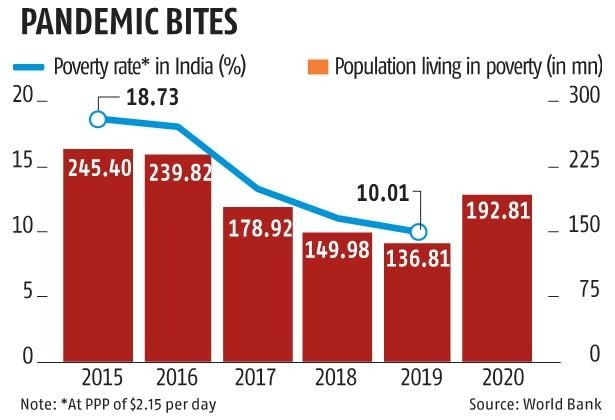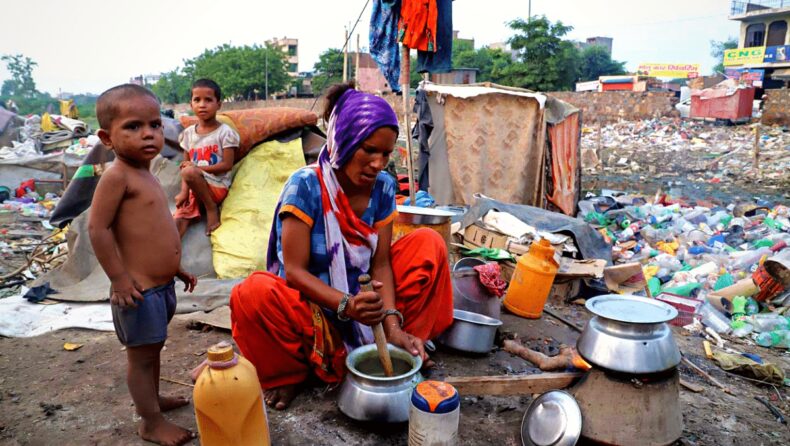The World Bank’s most recent study, “Poverty and Shared Prosperity 2022: Correcting the Course,” estimates that nearly 5.6 crore people in India became poorer with the onset of the COVID-19 Pandemic.
According to a World Bank analysis, approximately 80% of those who fell into poverty in 2020 as a result of the COVID-19 pandemic were from India. Indians made up 5.6 crores of the 7 crore persons that had become poor that year as a result of the pandemic’s economic losses.
COVID-19 and the Poverty Levels: Crisis worsens for the poor

According to the Poverty and Shared Prosperity 2022: Correcting the Course study from the World Bank, the COVID-19 epidemic “dealt the worst blow to global poverty in decades.”
World Bank RReport
Globally, the rate of extreme poverty increased to 9.3% in 2020 from 8.4%in 2019, halting for perhaps the first time in years the steps taken by programmes to reduce poverty. By the end of 2020, an extra 7 crore people would have been forced into extreme poverty, bringing the total number of poor people worldwide to well over 70 crores.
In contrast, according to the worldwide Oxfam Davos report of 2022, the richest people in India have seen their wealth more than double during the course of the Covid-19 crisis, which has wracked the nation and made poverty worse.
The World Bank updated its estimates of poverty in its most recent report, “Poverty and Shared Prosperity,” using a revised extreme poverty limit centred on the buying power parity (PPP) at $2.15 rather than the previous one, which was set at $1.9.
In the lack of data from the government’s Household Consumer Expenditure Survey during 2011–12, the multilateral lending institution used information for the Consumer Pyramids Household Survey (CPHS), performed by the Centre for Monitoring Indian Economy (CMIE).
COVID-19 Pandemic in India: The lack of data and the plight of the poor

Given that India’s population alone accounts for a sizable portion of the world’s poor, the World Bank noted that the absence of official statistics from India on poverty had made it difficult to create global estimates. The Indian administration has ceased releasing data on poverty since 2011.
According to the CPHS data for 2020, 5.6 crore Indians fell into poverty in that year. It added that the World Bank had relied on the Consumer Pyramids Household Survey results from the Centre for Monitoring Indian Economy (CMIE) due to the lack of official statistics (CPHS). The National Sample Survey Office of India’s most recent official statistics on poverty in India dates back to 2011–12.
https://www.worldbank.org/en/publication/poverty-and-shared-prosperity?cid=ce
Poverty and Shared Prosperity 2020 showed that due to India’s size, the lack of contemporary survey data for the nation greatly influences the assessment of global poverty.
The economic organisation did point out that its predictions of poverty in India stood far bigger than those in a study exemplified by the International Monetary Fund, which asserted that 2.3 crore Indians would encounter poverty by the year 2020.
The coronavirus pandemic, according to the World Bank assessment, caused a “historically substantial” worldwide shock to efforts to reduce poverty, even though the final figures may be higher or lower.
The World Bank estimates that there 7 crores more poor people worldwide in 2020 became poorer, with at least 5.6 crores of them living in India. Due to a lack of government statistics, other techniques are employed to determine poverty in India.
According to the research, the pandemic caused the rate of extreme poverty in the world to rise from 8.4% in 2019 to an expected 9.3% in 2020.
10.4% of India’s population, according to a previous World Bank prediction, would live below the $1.90 poverty line in 2017. However, the most recent estimate revealed that in 2017, 13.6% of people lived in poverty.
According to a World Bank report, 10% of Indians were living below the $2.15 revised poverty level in 2019–20. 12% of people in rural areas were considered to be poor, compared to 6% of Indians living in metropolitan areas.
However, the World Bank noted that between 2011 and 2020, when the epidemic struck, national poverty in India had begun to decline, mostly as a result of a decline in poverty in rural regions. According to the report, which covered the years 2011–20, “even if overall poverty has decreased, it is by less than what past figures used for worldwide poverty measurement would suggest.”
The COVID-19 pandemic worsened the situation of the poor populace since it was difficult for the government to assist individuals in need, according to the World Bank.

The COVID-19 pandemic ended a trend of reducing poverty both internationally and within India, and by 2020, based on the method of assessment, the population of the poor in India rose between about 2.3 crores and 5.6 crores.
The World Bank continues by stating that the reason for the significant variation in India’s poverty estimates for 2020 is that the Indian administration has not yet approved its 2020 poverty projections, necessitating the adoption of a variety of different methods to assess poverty in India.
Before the COVID-19 pandemic, poverty was also decreasing on a global scale. As per the World Bank, the pandemic has actually caused a historically significant increase in poverty levels worldwide.
It further stated that although the world crawled back to normal following the COVID-19 epidemic, increasing food and energy prices, which are aggravated by climate change and the ongoing war between Russia and Ukraine, have impeded a timely recovery.
“The world is unlikely to meet the goal of ending extreme poverty by 2030 absent history-defying rates of economic growth over the remainder of this decade.”
An age of worldwide income convergence ended in 2020, and a new phase of global income dispersion began. The pandemic cost the poorest individuals in the world the most. Income levels in the poorest nations decreased significantly more than earnings in wealthy nations. The research noted that as a result, global inequality increased for the first in decades, with the economic losses of the world’s poorest people being twice as great as those of the richest.













